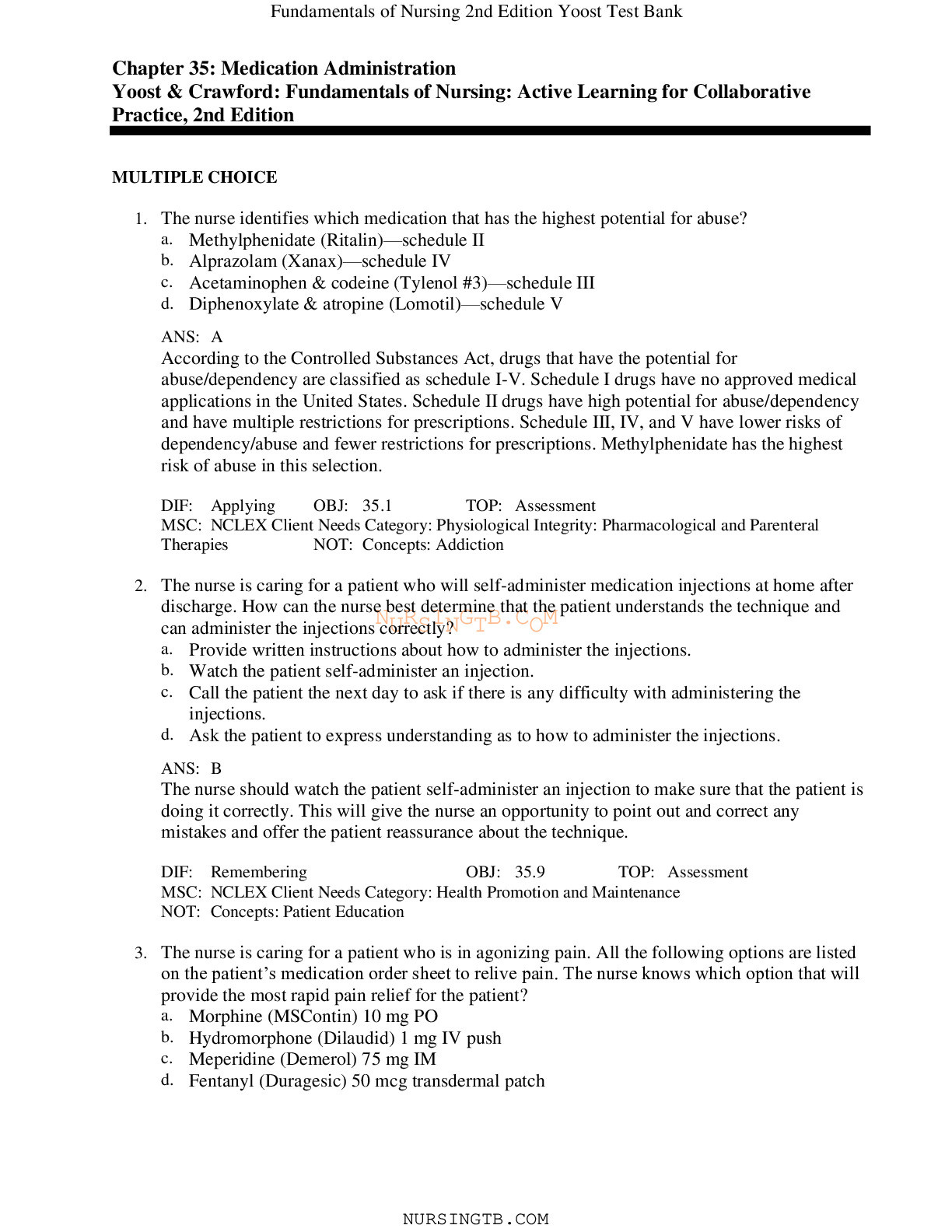All study resources > Chapter 35: Medication Administration Yoost & Crawford: Fundamentals of Nursing: Active Learning for Collaborative Practice, 2nd Edition (Nursing)
Chapter 35: Medication Administration Yoost & Crawford: Fundamentals of Nursing: Active Learning for Collaborative Practice, 2nd Edition
1. The nurse identifies which medication that has the highest potential for abuse?
a. Methylphenidate (Ritalin)—schedule II
b. Alprazolam (Xanax)—schedule IV
c. Acetaminophen & codeine (Tylenol #3)—schedule III
d. Diphenoxylate & atropine (Lomotil)—schedule V
2. The nurse is caring for a patient who will self-administer medication injections at home after
discharge. How can the n
...[Show More]
1. The nurse identifies which medication that has the highest potential for abuse?
a. Methylphenidate (Ritalin)—schedule II
b. Alprazolam (Xanax)—schedule IV
c. Acetaminophen & codeine (Tylenol #3)—schedule III
d. Diphenoxylate & atropine (Lomotil)—schedule V
2. The nurse is caring for a patient who will self-administer medication injections at home after
discharge. How can the nurse best determine that the patient understands the technique and
can administer the injections correctly?
a. Provide written instructions about how to administer the injections.
b. Watch the patient self-administer an injection.
c. Call the patient the next day to ask if there is any difficulty with administering the
injections.
d. Ask the patient to express understanding as to how to administer the injections.
3. The nurse is caring for a patient who is in agonizing pain. All the following options are listed
on the patient’s medication order sheet to relive pain. The nurse knows which option that will
provide the most rapid pain relief for the patient?
a. Morphine (MSContin) 10 mg PO
b. Hydromorphone (Dilaudid) 1 mg IV push
c. Meperidine (Demerol) 75 mg IM
d. Fentanyl (Duragesic) 50 mcg transdermal patch
4. The nurse administers a medication to a patient. Shortly afterward, the patient develops an
itchy rash over the entire body and reports feeling very unwell. What is the priority action of
the nurse?
a. Leave the patient to notify the provider and the pharmacist.
b. Determine if the patient is having any difficulty breathing.
c. Document the reaction in the patient’s chart.
d. Obtain an order for hydrocortisone cream to relieve the itching.
5. The nurse identifies which medication order to be administered PRN?
a. Zolpidem (Ambien) 10 mg PO tonight if the patient cannot sleep
b. Prednisone 10 mg PO today, then taper down 1 mg each day for the next 10 days
c. Humulin R 10 units subcutaneously before each meal and at bedtime
d. Kefzol (Ancef) 1 g IVPB 30 minutes prior to surgery
6. After administering an antibiotic to the patient, the nurse notes the patient complaining of
feeling ill, is scratching and has hives. The patient soon starts having difficulty breathing and
is hypotensive. What is the nurse’s assessment of the situation?
a. The patient is having a mild allergic reaction and an antihistamine will make the
patient feel better.
b. The patient is having an anaphylactic reaction and epinephrine should be
administered right away.
c. The patient’s infection is worsening and progressing to septic shock so blood
cultures should be drawn.
d. The patient has developed toxic shock syndrome and the antibiotic orders must be
changed right away.
7. The nurse makes a medication error. Which action will the nurse take first?
a. Prepare an incident report.
b. Explain to the patient that a medication error has occurred.
c. Assess the patient for any adverse reactions.
d. Document the medication given, the response, and corrective actions taken.
[Show Less]
